I’m back with the second half of the Northwoods set from Replica Toy Fish. I looked at the other three species here, and now I’ll look at the other three, also three popular sport fish in more northern areas of North America (one of which is naturally found more broadly). The species today are all in the family Esocidae, the pikes: the muskellunge Esox masquinongy, the northern pike Esox lucius, and the tiger muskie Esox masquinongy x lucius (a hybrid of the northern pike and muskellunge). I will look at each one individually once again. I already covered the species for the latter two, so I won’t go into great detail on them again. As with some of other Replica Toy Fish posts there will also be some bonus models, And this time, one of them is my fault! Some are different species, some are just wild variations!
EDIT May 22 – okay, so a bit of luck in finding a wayback machine archive indicates that the assignation of muskellunge and tiger muskie below may be backward; based on the site, the darker figure was intended to be the muskellunge and the lighter figure the tiger muskie. Both are still very ambiguous so I won’t be changing them here, but take them as you will–the colouration is too similar, and the mixing of physical features (and missing of other features) means that they are still very difficult to be truly certain. Almost like finding a maybe-hybrid in a pond? UPDATE – okay, reviewing again, and in spite of what the RTF site labelled them, the pointed tail tips of the light red figure is probably the key recognizable feature of a muskellunge, not a tiger muskie. So I’m leaving the ID as is here.


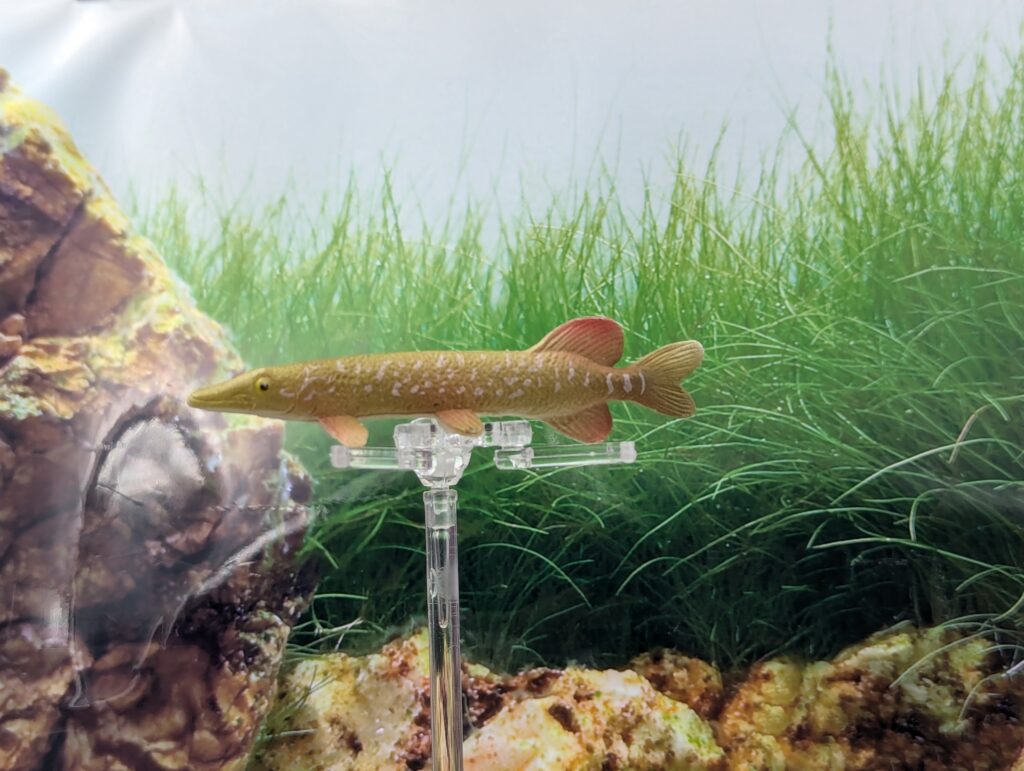
Muskellunge Esox masquinongy

This is the only figure in today’s post that did not see a 6 inch version as well, so I’ll be covering it in my usual exhaustive detail! This figure is the muskellunge, Esox masquinongy, the largest member of the Esocidae family. Their life history is very similar to their fellow pike species, aggressive ambush predators that dart out and capture whatever prey they see. The major difference is their size; northern pike can get quite large, but on average muskellunge are overall bigger, usually around 95cm (37 inches) although capable of reaching over 180cm (6 feet). Like other pike, they are freshwater fish, preferring clear lakes, ponds and large rivers with plenty of cover to lurk and areas to rest. Muskellunge will have two territories in the summer, a smaller shallow one (where the water is warmer) and a larger deeper one, but may be more gregarious than northern pike, forming small schools within territories. Muskellunge range in the drainage areas of the northeast US and Canada around the St Lawrence River and Great Lakes; they’re desirability as sport fish has also seen them introduced in other areas, occasionally finding their ways into other waterways where they can pose a threat to native fishes. There are apparently 3 probable subspecies, but the figure today won’t have the detail to reflect that! While the real giant monsters are quite rare, the species overall is listed as Least Concern by the IUCN.
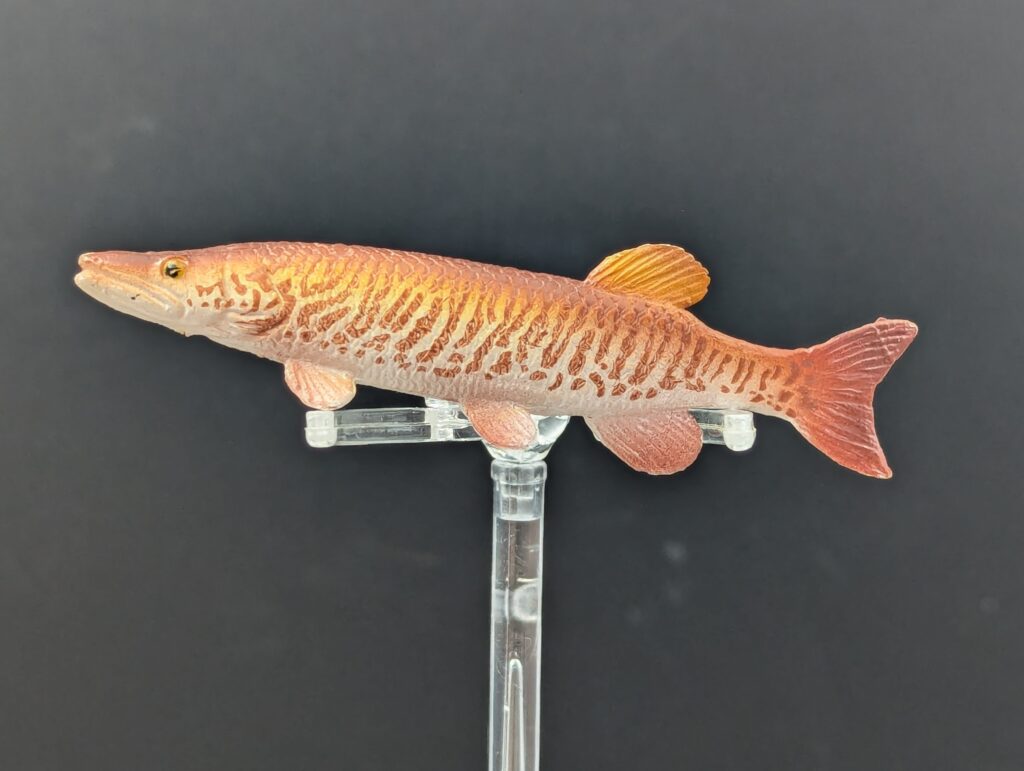

Describing the figure adds an extra challenge that it is very similar to the tiger muskie figure (see next!). Both are very similar, and I think that even on the tackle box, the only reference guide that lists all of the species, their images didn’t really help because the two figures were painted in very similar ways. The key point is that muskellunge have more pointed tails than tiger muskies; usually the colour pattern and pectoral fins are also helpful but not in this case…the overall colour is a white body, with a light umber stripe overlay and spots along the lower flanks; there is actually a lot of variation in muskellunge patterns, from nearly patternless or light spots, to different amounts of striping, to dark striping and dots that are more brown. This latter pattern is referred to as a ‘leopard muskie’ and is probably what was intended for the figure, maybe because it stands out so much from the northern pike; the patterning of muskellunge is often reflected in their general habitat conditions. The fins are all painted lightly in the same ochre, and the tail is a solid dark brown.

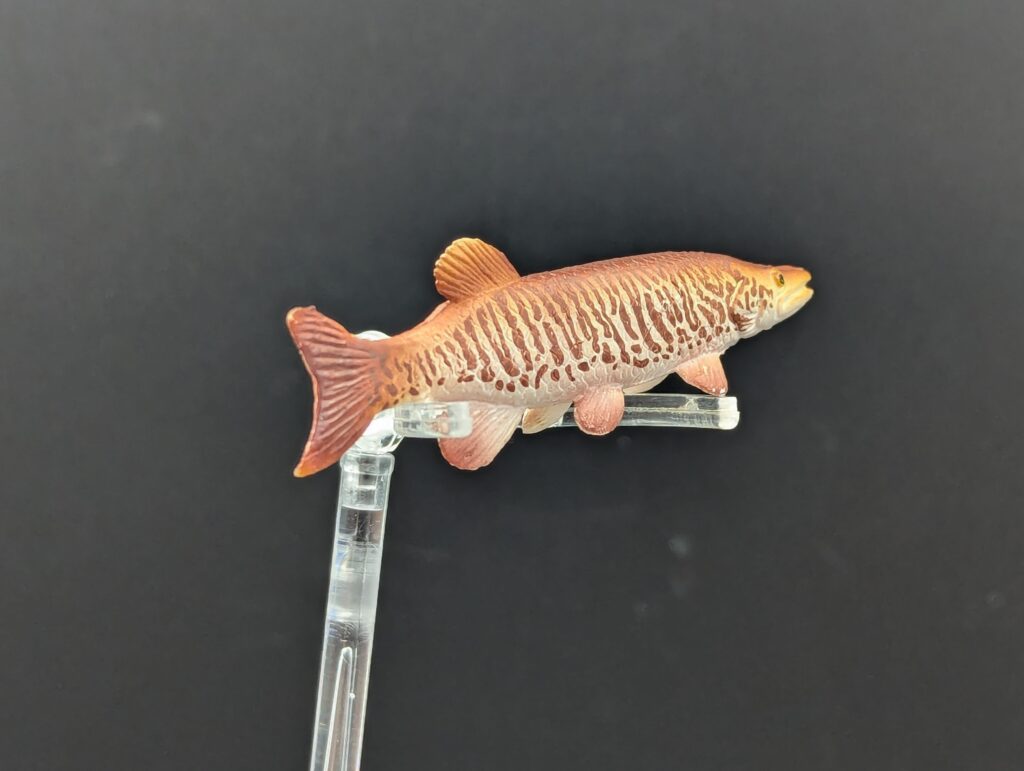
The overall look of the figure is pretty good. It is about 8.4cm long, giving a scale of about 1:11 for an average individual. Of the three 3″ pikes we’re looking at, it has the deepest body of the three, giving it more apparent heft. The mouth is sculpted with a slight downturn below the eye, indicating a very large mouth, and the eye is large and sloppily painted black…the paired fins are short and rounded, sticking out from the body, and the dorsal and anal fin are both extended out quite far with very rounded margins, although they should come to a point (this becomes important soon). The caudal peduncle is relatively long, extending into the tall, forked tail. The tips on the tail noticeably pointed. In general, this is a good sculpt of a muskellunge, but to be honest the later revamp from Toy Fish Factory is painted a little more clearly, and captured the dark spots that should be on the tail (although reflecting the same leopard pattern, and still being far more brown than green).
Bonus Muskellunge figures

As have shown up in previous posts, I received a few differently painted muskellunge figures. Both appear to be variations on a theme of a more green-base with that same barred or leopard pattern. In the first model, the base is a very light greenish-yellow with thin stripes and spots in darker green; the spots also continue into all of the fins. Along the back, the figure is a fairly solid brown colour, more like the actual release version. The overall sheen of the figure is shinier, which looks more realistic as well.


The second figure may not have been completed, but seems to be going for something different. The back is an olive green, and the sides have been painted a lighter green so that the base colour shows through as the stripes and spots. Once again, the spotting is extended into the fins, a correction on the released model. The underside of this one appears to be translucent, I believe being the actual cast material left unpainted.

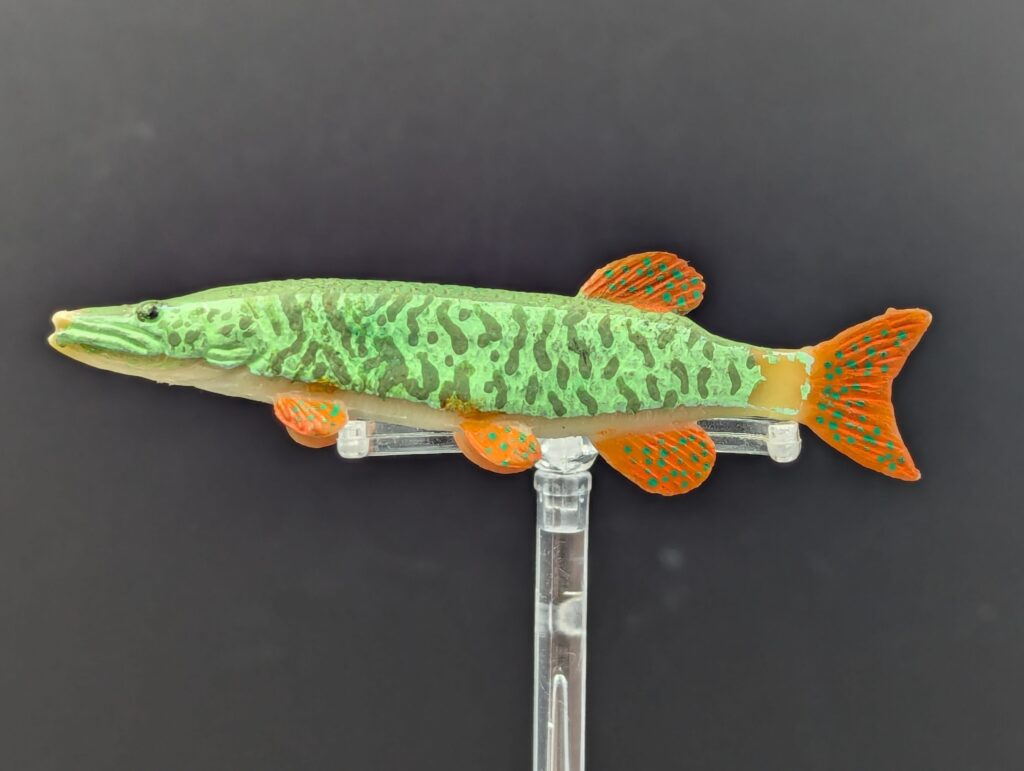
Overall, both models look like they were on the way to something a little more true to life for the species if they’d been completed.

Tiger Muskie Esox lucius x masquinongy

Next we have the hybrid species, the tiger muskie, discussed at length here. It looks distinct enough from the muskellunge figure above, but very similar, and given those similarities I had a really hard time being sure which was the tiger muskie and which is the muskellunge. It doesn’t help that the painter went with a burnt umber on one, and a light umber on the other. But the round tail is probably the most identifiable way to be sure. Again, it would have been nice to have name stamps (can’t believe this is still not standard with toy animal makers) and the artwork used on support materials was licensed/commissioned from very good artists; in and of itself that’s great, but the toy painters didn’t follow those patterns at all.
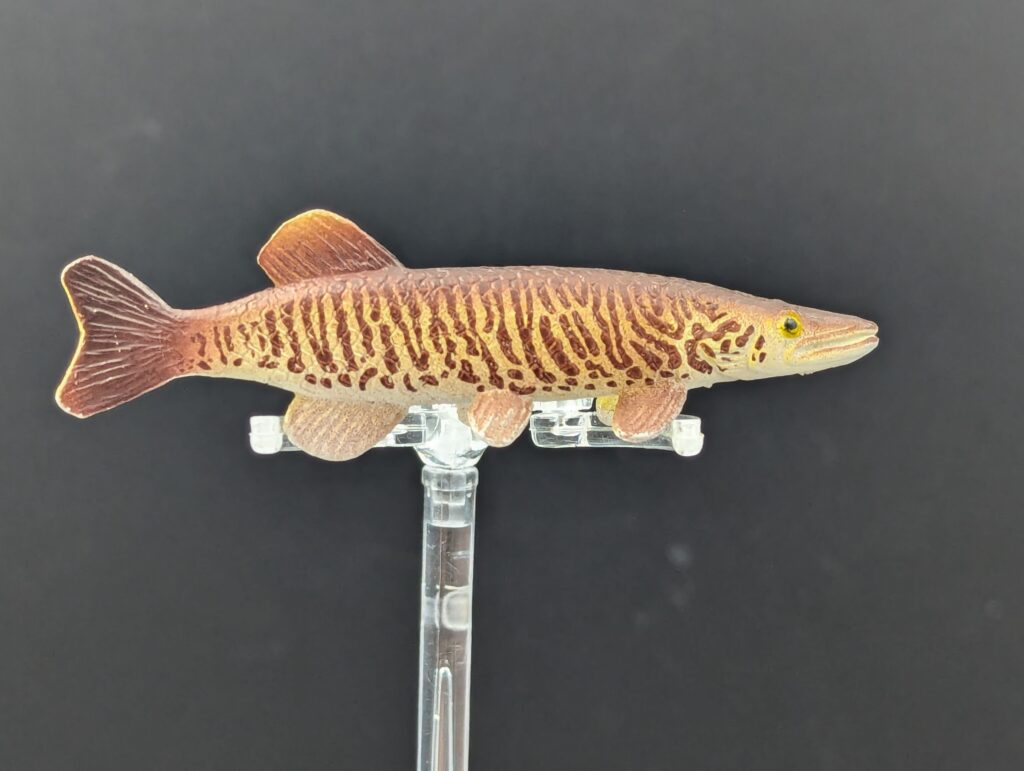

Anyway, to describe the figure, it is indeed very similar to the 3″ muskellunge. It is shorter, about 7.6 cm long (3″) which, assuming a giant, would be about 1:17 but of course can range smaller. The sculpt is a little more robust than the muskellunge, or at least appears that way, and the head seems just a bit shorter and heavier too (or, maybe it’s just me, they are very similar in hand). This does keep with my assumption that the darker figure is the tiger muskie, as the mouth appears to have just a bit more upward curve. The posterior fins, both dorsal and anal fins, are large and somewhat squared, I think to reflect the northern pike ancestry. The tail, as mentioned, has rounded tips which is characteristic; the paired fins are also slightly rounded…the issue being that in tiger muskies, these are usually more pointed (as in northern pike)–as it turns out, the northern pike (see below) also has rounded pectoral tips…so sculptor choice I guess.

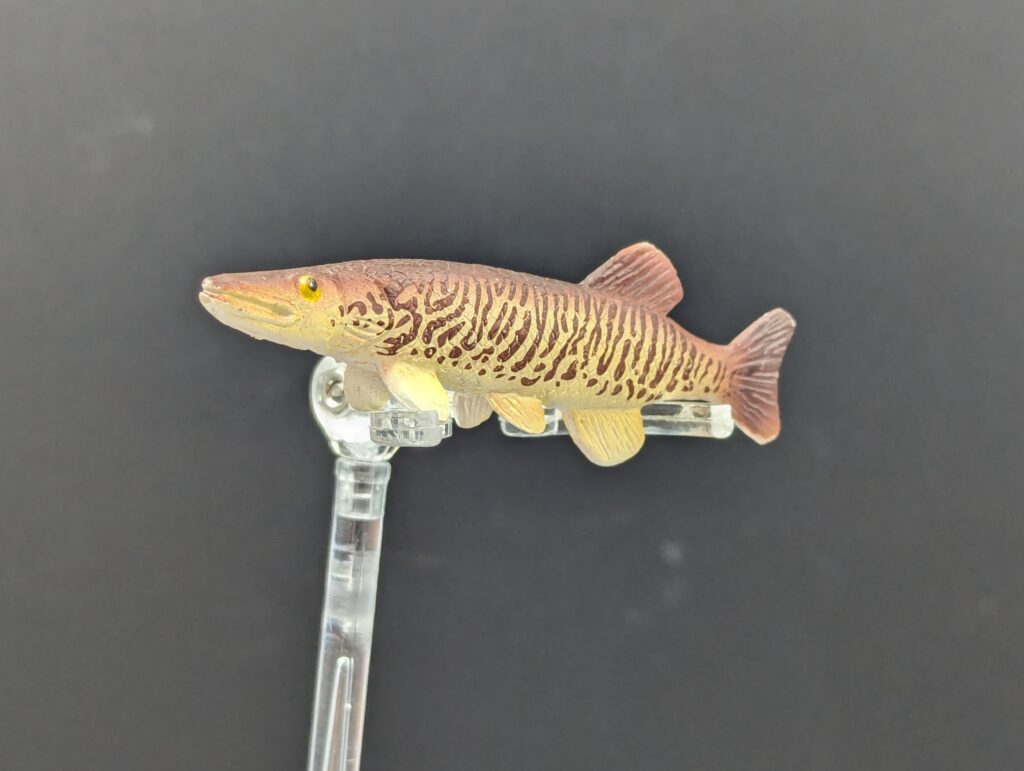
The overall colour is a slightly darker white or cream, with the forked striping and small blotching in the aforementioned darker umber. At minimum, this reflects the tiger muskie pattern, with the light body colour and coloured markings. The back, including the dorsal fin, and the head are solid dark umber, as is the tail; the other fins are the off-white base colour. Overall a good, small figure of this unique and popular hybrid–just a bit of a challenge to differentiate it from the muskellunge parent! I’d be willing to bet that many kids that received the full set might have thought they received two of the same species (again, toy companies, label your animals!) Interestingly, I sold Replica Toy Fish figures for years, and the only models I have left are a few each of the tiger muskie and muskellunge…I don’t exactly know what meaning to take from that…

Northern Pike Esox lucius

The last species is the northern pike Esox lucius, the other pike species covered in depth as a 6″ figure. The sculpt of this figure is noticeably more lithe than the muskellunge and tiger muskie, with a far shorter depth and thinner lateral profile. It is also the longest of the three figures, at 8.7 cm (almost 3.5″) in length, giving a 1:18 scale for a very big specimen.
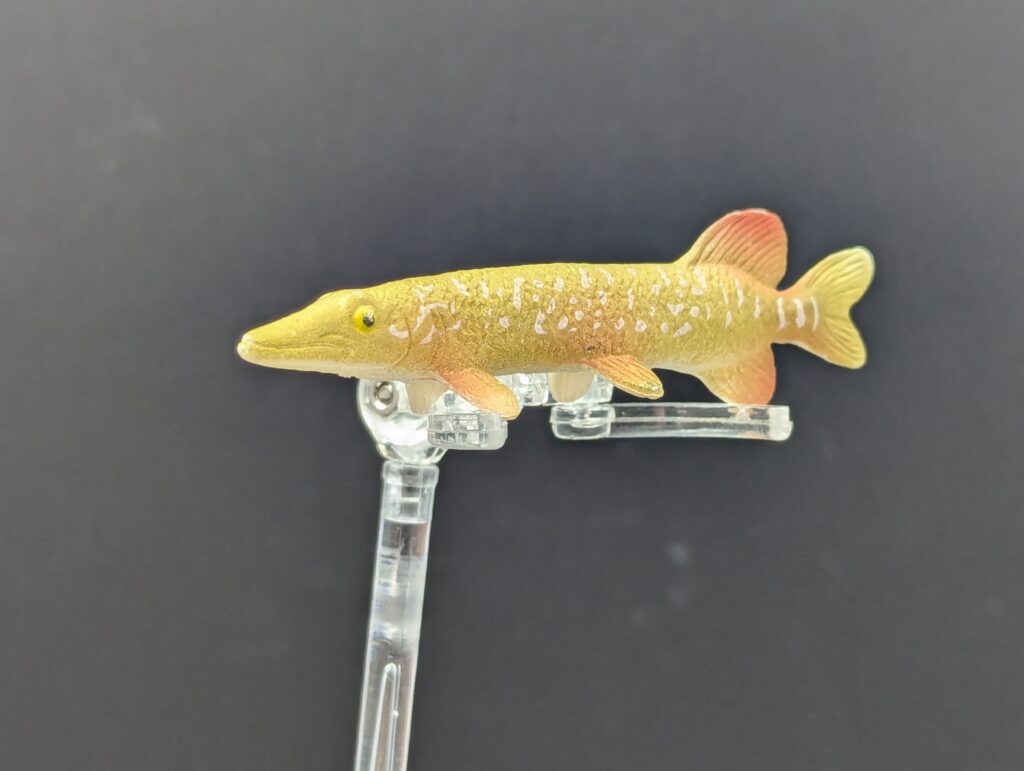

The snout is much longer than on the other two models as well. The paired fins are small and rounded (should be pointed), and the anal and dorsal fins are very high and very rounded; not inaccurate, but definitely seem almost too much for the figure. The tail fin is also quite broad and very rounded, almost heart-shaped. In a way, it almost comes across as a juvenile of the 6″ model, being quite skinny with weirdly large fins. There may be a different reason for this shape–it’s certainly not as robust as a northern pike is usually depicted–but I’ll get to that much later in the series.
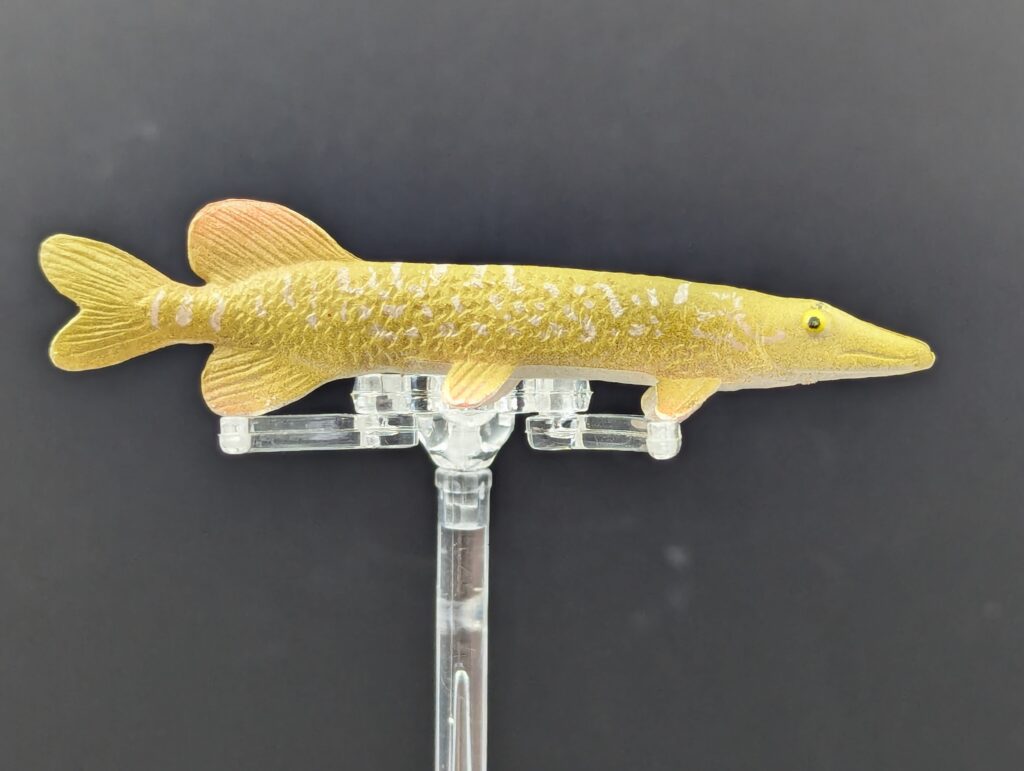
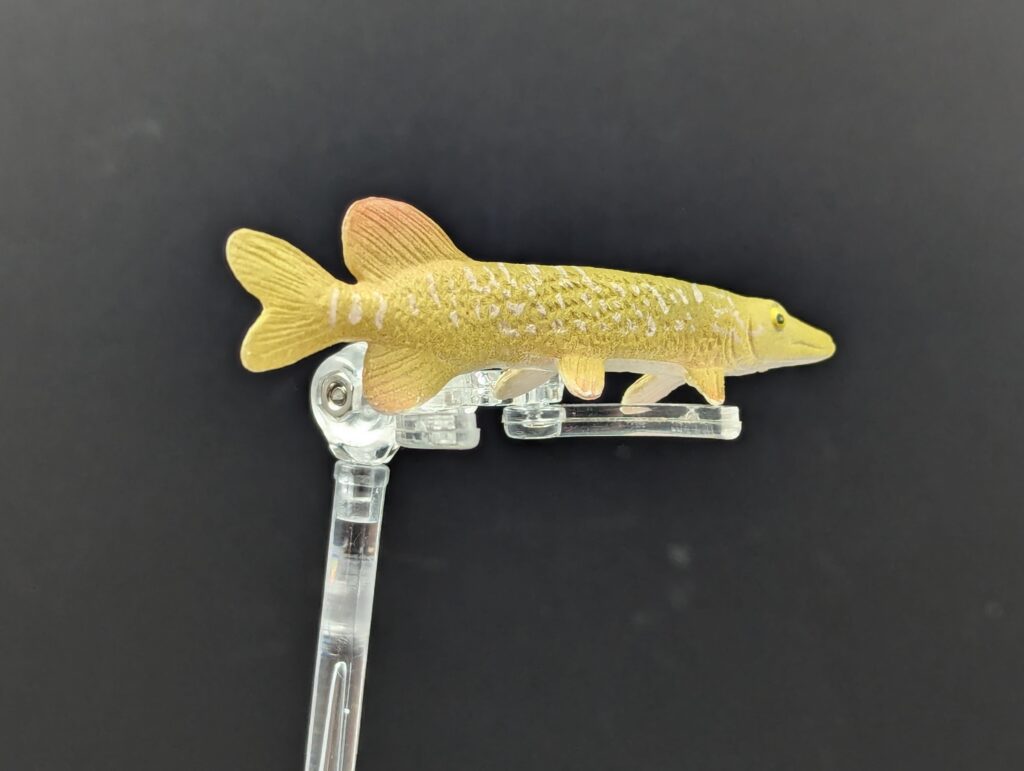
The colouring is very similar to what is seen in the 6″ figure as well, with a light green base overall, including into the tail, and light red highlights on the body fins; some of this does spread onto the main body as well, although it shouldn’t. I should mention that the painting on all RTF 3″ figures could be quite inconsistent so some of this may not be seen in every figure. The body is covered in numerous small irregular white markings, with barring on the caudal peduncle. The eyes are painted as simple black dots (sloppily, on the right hand side…). Overall, it is fine as a northern pike figure, if a little thin, and the later Toy Fish Factory version definitely improved on it.
Bonus figure Amur pike Esox reichertii

So this one is an obvious repaint, but unlike most of the paint variants, this one was done by me, mostly because I could (I had several spares at the time)…I was inspired to look up the different Esox species when I learned that the northern pike had a few recently-identified species (E. cisalpinus and E. aquitancicus) and discovered this other distinct looking species that was described in 1869. I’d never had reason to learn of the Amur pike Esox reichardtii until then, but I was intrigued by the distinct and unique pattern and decided to give a try at recreating one. Overall, Amur pike are fairly large, around 115cm (45 inches) long, with a very light silvery body and a pattern of small black dashes or spots, and reddish fins. They are found in the Amur River basin in eastern Russia and China, active predators that ambush their prey like all pike species. They are also popular with anglers, although are not usually found outside of that range (a few attempts at introductions in the US have been made but don’t appear successful). They are currently listed as Least Concern by the IUCN.
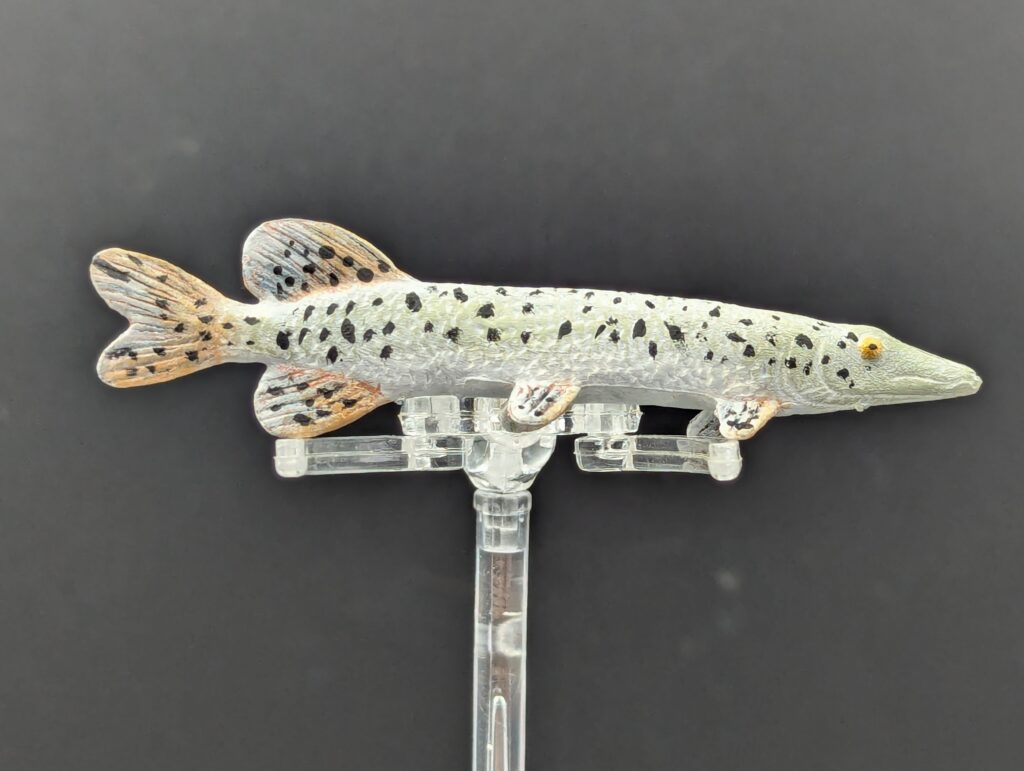

Obviously, the sculpt is exactly the same as the northern pike, although in retrospect the muskellunge or tiger muskie might have suited the fin shape better. Given that the model is the same size as the northern pike, it is 8.7 cm, so the scale would be 1:14. My attempt sees the fish with a very light, off white back and sides, with a lighter belly. All fins are painted a light red with white edges (this varies on the fish) all with black spots; it appears that many Amur pike actually have dark stripes along the fin rays, but others have spots and that was my inspiration. The body is covered from the back to the sides with black spots and blotches; they are spaced irregularly, but in the grand tradition of esocids these markings can be very regularly spaced, very faint, a much larger number of tiny spots, or even thin stripes (my guess, as it was years ago–I wanted to go with the most distinctive look). The eye is copper with a black pupil. I am okay with it, I don’t do much painting (you’ll see another attempt eventually) but it just seems like this is a species that is so unique, it needed attention, and I guarantee no one will officially release one. Maybe I’ll redo one of those muskie spares into one someday, but this’ll do for now.
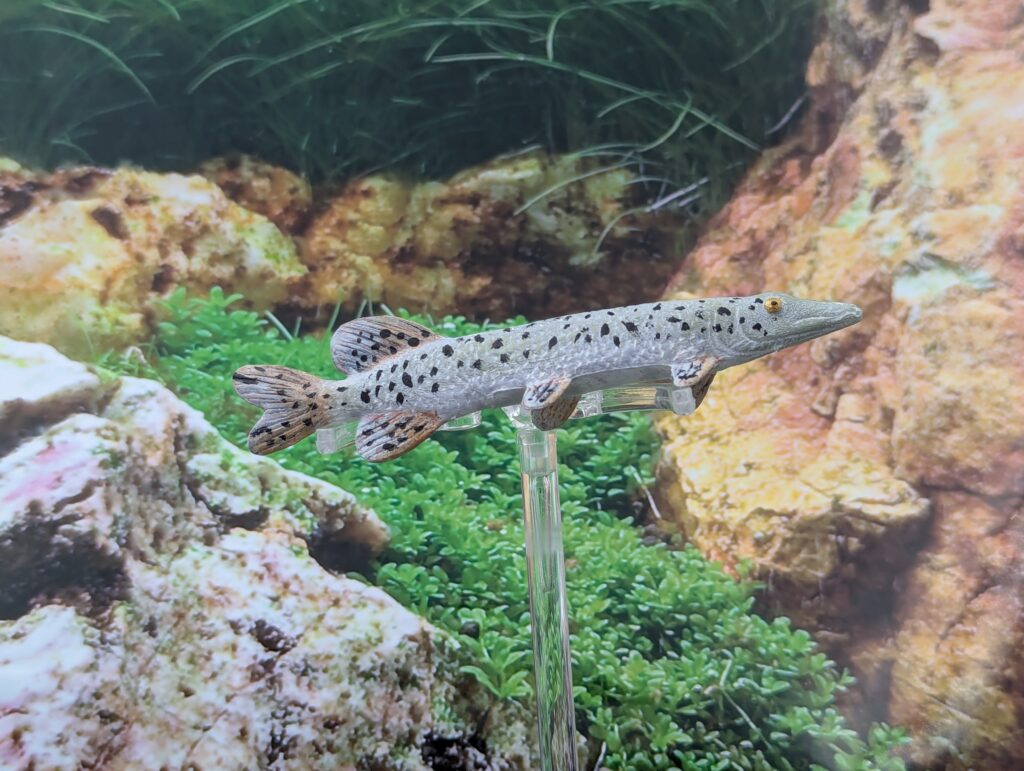
So that’s the full Northwoods set from Replica Toy Fish, also known as half of the figures in the American Angler tackle box, also known as half of the original dozen 3″ figures released by Replica Toy Fish. Next time I’ll be starting with the second half, the ‘Pond Fish’ set!
Disclaimer: links to Ebay and Amazon on the AnimalToyBlog are affiliate links, so we make a small commission if you use them. Thanks for supporting us!



